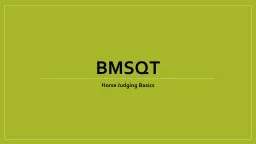

Tools for Judging Horse Colors Horse Markings Face Markings Leg Markings Parts of the Horse B Balance The overall impression at first glance is a good indicator of balance Does the horse make a pretty picture or does the neck look too short or the back too long ID: 930957
Download Presentation The PPT/PDF document "BMSQT Horse Judging Basics" is the property of its rightful owner. Permission is granted to download and print the materials on this web site for personal, non-commercial use only, and to display it on your personal computer provided you do not modify the materials and that you retain all copyright notices contained in the materials. By downloading content from our website, you accept the terms of this agreement.
Slide1
BMSQT
Horse Judging Basics
Slide2Tools for Judging
Slide3Horse Colors
Slide4Horse Markings
Face Markings
Leg Markings
Slide5Parts of the Horse
Slide6B = Balance
The overall impression at first glance is a good indicator of balance. Does the horse make a pretty picture or does the neck look too short or the back too long.
See poster – does the horse divide evenly into thirds: head, neck and shoulder/back and barrel/loin, hind quarters
Or, see poster – can you draw even circles from the withers around the shoulder, arm and up the heart girth area/then another circle from the top of the croup, around the point of hip, down flank area, under bottom of stifle, up by point of the buttocks, back to top of croup
Slide7Balance, cont.
Does the head attach cleanly at the neck, is the neck long and come out of the shoulder correctly, does it all tie into the shoulder well (not too low)
The heart girth should be deep, with a prominent withers. The back and loin (topline) should be short and strong blending in to a correctly sloping croup. The heart girth and barrel (underline) should be longer than the topline
Slide8Visualize Balance Using Circles
Slide9Visualize Balance Using Thirds
Slide10M = Muscle
Muscle masses include: shoulder, arm, forearm, hip, stifle, gaskin
Muscles should be well defined in the Quarter horse (stock type). They will have thicker more defined muscling than a thoroughbred or saddle bred. Thoroughbreds, Saddlebreds and Arabians muscling is longer and may not be as defined
From the front view there should be an upside down “V” in the chest (pectoral) area.
From the rear view there should be an upside down “V” under the tail to show muscling
Slide11S = Structural Correctness
There should be a ~ 45 degree angle from the point of the withers to the point of the shoulder and the same angle for the pasterns. These angles act as shock absorbers for the horse and a steep angle in the shoulder and pasterns will cause a horse to be rough.
The distance from the point of the hip to the point of the buttock should be similar to the shoulder measurement (which is another indicator of balance). There should be some angle there as well so the horse can move his hind legs up under him.
Regarding legs, study charts in Publication ASC 118 they show the ideal stance from the front and rear and several deviations from the ideal
Slide12Diagram sources from Horse Industry Handbook
Slide13Structural Correctness – side view
Slide14Structural Correctness – croup and hip
Slide15Structural Correctness – rear legs side view
Slide16Structural Correctness – front view
Slide17Structural Correctness – front view travel
Slide18Structural Correctness – rear view
Slide19Q = Quality
Look at quality from the head to the tail. The head should be well shaped with an appropriate size alert ear (shorter for a stock horse or Arabian; longer for a Thoroughbred or Saddlebred type). The jaw should be well defined, and masculine looking for a gelding or stallion. A mare’s head should look like a mare, showing a feminine look. The bone should be appropriate to the breed. Stock horses will have shorter bones with more substance compared to a Thoroughbred, Saddlebred or Arabian
The hair coat should be shiny (even a long haired horse can be determined to have a healthy hair coat or a poor dull hair coat).
Slide20T = Travel
A horse’s travel will likely be predictable from the structure of their front and hind legs as shown in ASC 118.
It has been my experience that in a 4 horse judging class, less emphasis is placed on this because there is not always uniformity in the way handlers handle the horses or in the way the horses behave.
Slide21Judging Card
Slide22Optional note format for practicing
Slide23An Oral Reasons Format
Slide24Additional Resources
Breed Associations have posters, brochures, booklets you can order
Breed Associations may have judging videos you can purchase
UK Publication ASC 118
Other Universities have resources for which you can search
Slide25Prepared by Paula Hopkins Jerrell
Ballard County Extension Agent for 4-H Youth Development
District 7 4-H Horse Contact